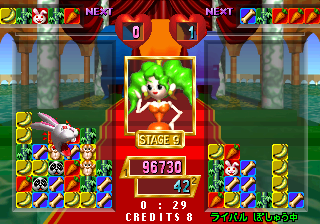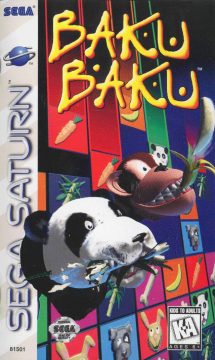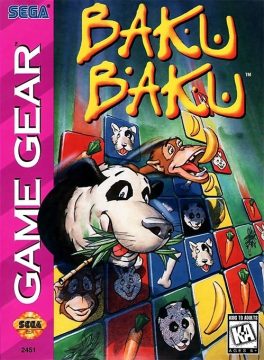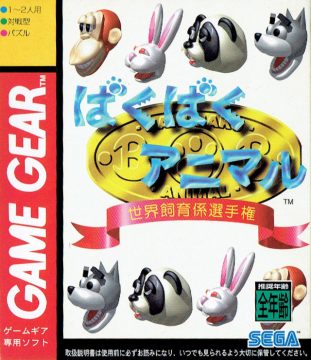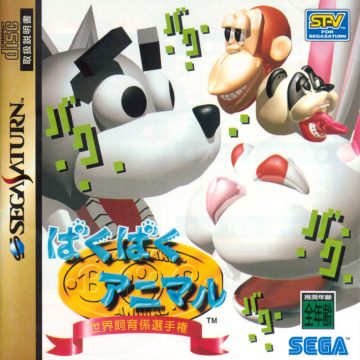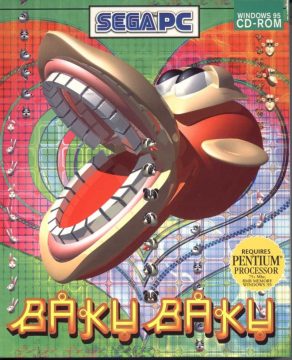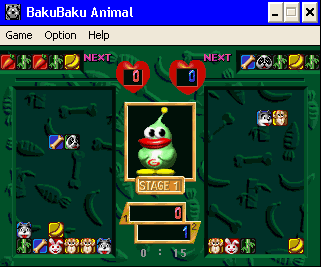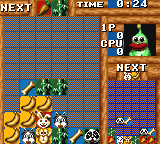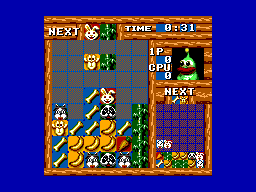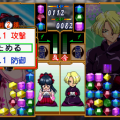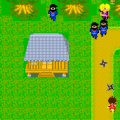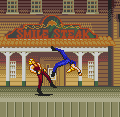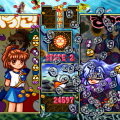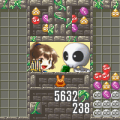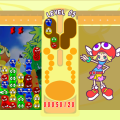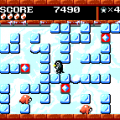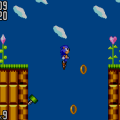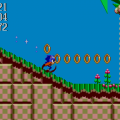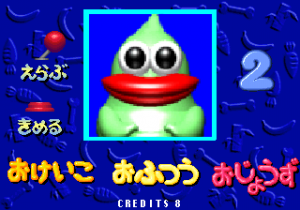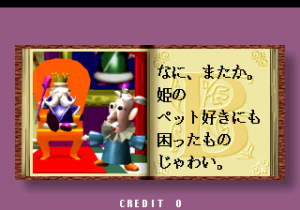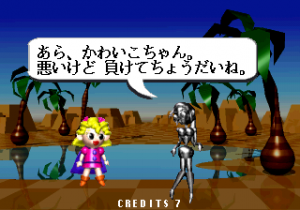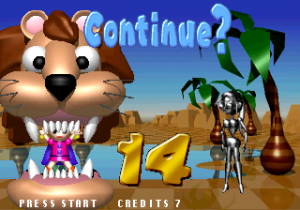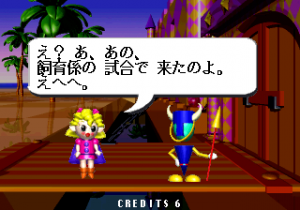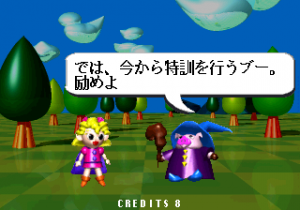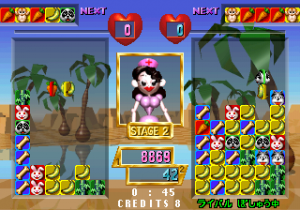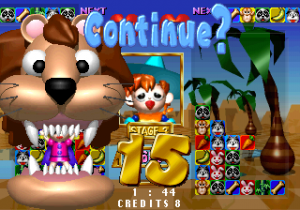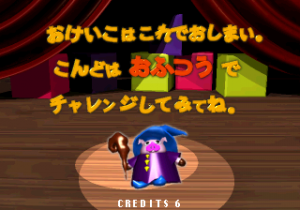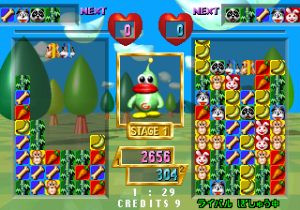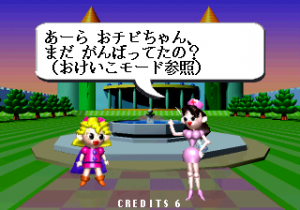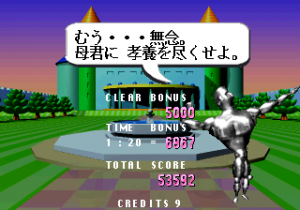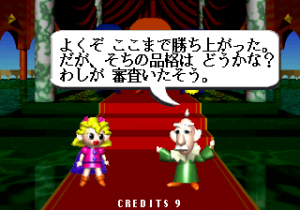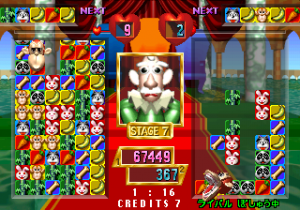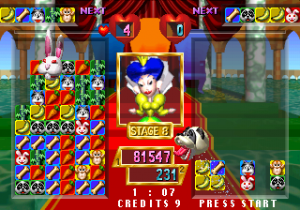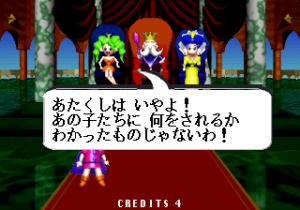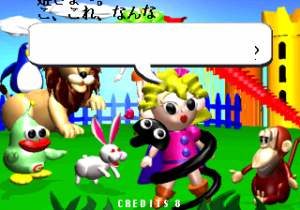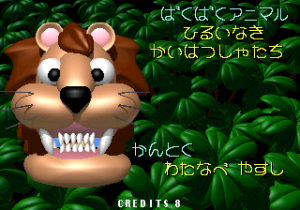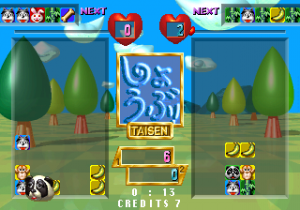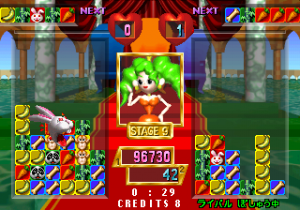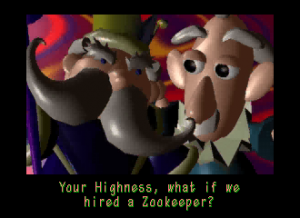Sega has always had a strong foothold in the puzzle genre, thanks to long running franchises like Puyo Puyo and Columns. In between those releases, Sega made some attempts to inject the genre with new life and their lovable, oddball charm with games like ChuChu Rocket! and the Puzzle & Action series. Baku Baku Animal (just Baku Baku outside of Japan, which roughly translates to “chomp chomp”) was one such attempt, and much like ChuChu Rocket!, it never got the chance to become a franchise. Developed for Japanese arcades in 1995 by Sega AM3’s R&D Division, who would later become known as Hitmaker, it would be the team’s one and only shot at the puzzle genre. Taking notes from Puyo Puyo, it’s a falling block puzzle game with an emphasis on chaining together combos, but it stands out thanks to its spin on the moment-to-moment gameplay and visuals that are endearing and unsettling in equal measure.
In an unnamed kingdom, an animal-loving princess has so many pets that her servants can no longer keep up with caring for them all. The king and his minister come up with a plan to hire a royal zookeeper by holding a competition involving “games of skill and strategy” to see who is most worthy of the title. As the hopeful Polly, you’ll need to beat nine opponents, including the royal family themselves, in order to prove that your zookeeper skills are the real deal. The cast of characters is amusingly eclectic, ranging from Master Piggy, a pig wizard who serves as a mentor to Polly, a strange penguin-like creature called Gallopy, to a woman named Angela who is clad entirely in metallic silver, much like Dural from Sega’s Virtua Fighter series. While there isn’t much in the way of dialogue, with only brief snippets before and after stages, it’s enjoyable to witness the trash talking that goes on between the characters and gawk at how quickly the royal family is willing to threaten a little girl with imprisonment for losing.
Players will immediately notice the game’s standout aesthetic, which feels like a combination of early 3D modeling and Claymation in the way the characters look like cartoonish, plastic toys. Vibrant colors are everywhere, and each character is visually distinct with expressiveness that changes depending on the context – just like Puyo Puyo, whenever players are winning a match, the opponent will start to get nervous or freak out, whereas if the player is losing, their opponent will look confident as they await the player’s failure. This is also reflected in the dialogue between matches, where Polly will get flustered or angry when one of her opponents is rude to her and ecstatic when she manages to win a match. It’s a great touch that gives the characters plenty of life despite their limited screen time. This expressiveness also carries over into the puzzle pieces themselves, which upon being matched correctly, summon a giant animal head to gobble up the pieces, accompanied by a gratuitous chomping sound. The giant animal heads are more unsettling than cute though, and the game gets downright dark with its game over screen that depicts a giant lion head eating Polly should the player choose not to continue.
Much like other puzzle games in the falling block subgenre, the goal in Baku Baku is to create combos to clear out enough of the blocks on your side of the screen in order to fill up your opponent’s playing field with blocks. The twist here lies in how this is accomplished: rather than simply matching three or four pieces of the same color, players will have to match up animal blocks with the appropriate food blocks. There are four types of animals (dog, panda, rabbit, and monkey) and four types of foods (bones, bamboo, carrots, and bananas), and all it takes is one of each in order to create a match. However, matching up blocks one by one isn’t enough, since an animal will have to clear out at least three food blocks in order to send anything over to the opponent’s side. The blocks sent over to your opponent’s side aren’t the usual garbage blocks seen in Baku Baku’s contemporaries, but are instead just a random assortment of blocks, which can actually be more difficult to process in the heat of the moment. To make matching both easier and more dynamic, all connected blocks of the same type will be cleared out when an animal starts to eat them, so you can create lengthy matches going in all directions. This gives Baku Baku something of a unique metagame, where the standard strategies of other competitive puzzle games, such as creating sandwich or stair patterns, don’t work in quite the same way, forcing players to adjust those ideas and create elaborate, freeform patterns that can span a sizeable portion of the playing field. Interestingly enough, Capcom’s Super Puzzle Fighter II Turbo would go on to inherit several of Baku Baku’s ideas, namely the relationship between crash gems and regular gems that works in much the same way as the animal and food blocks in Baku Baku.
Games in Baku Baku become intense quickly, starting off fast and increasing in speed as the timer counts down. Victory against tougher opponents requires you to optimize the speed at which you assemble chain reactions, and since there’s no way to defend yourself from incoming blocks, games can often come down to whoever manages to pull off a big combo first. Luck is undeniably a factor as well, between which blocks are provided to the player and whether or not they can live long enough to see BB coins, game-changing blocks that instantly clear out all blocks of the type that they make contact with. All of this action is mixed in with an energetic, upbeat soundtrack alongside plenty of sound clips that play whenever combos are made, making for some noisy games and potential overstimulation. Thankfully, the game has three difficulty options that allow players to work their way up to tougher opponents, though the easy mode is somewhat pointless and only contains three out of the nine stages. Difficulty choice also affects your potential opponents – Master Piggy is only found on easy mode, whereas hard mode skips Gallopy and has you do battle with both gold and silver versions of Angela, so trying out all three modes adds a bit of replay value.
The first port of Baku Baku would arrive on the Saturn the same year as the arcade game in Japan and a year later in North America (Europe would have to wait until 1998). The Saturn was a natural fit for the game, considering that the game was developed for the ST-V arcade board that was based on the Saturn’s hardware in the first place. As a result, the Saturn version is by far the most faithful of the game’s ports in terms of visuals and sound. Those who choose to play the North American or PAL release are in for a surprise though, as these versions remove almost all of the game’s dialogue and cutscenes, leaving only the final stage’s dialogue and a new CG intro and ending behind. The North American release also hides the Saturn-exclusive “League Mode” behind a cheat code, and even if you do unlock it, it’s still entirely in Japanese! Despite these issues, there are several new additions that make the Saturn version the most robust in terms of features. For starters, it’s now possible to play though the “Arcade Mode” as Gon, the player two character, and there are several new options that can be toggled for all modes. These options include two extra CPU difficulties (Very Easy and Very Hard), a Saturn-exclusive remixed soundtrack, and the ability to adjust the number of block types that can appear, including a new fifth block type, a mouse block that must be paired with a cheese block. There’s also a new “Ranking Mode” in which the game evaluates the player’s ability based on how quickly and efficiently they can run through the CPU opponents. If one can read Japanese, the Japanese Saturn version could easily be considered the ideal version of the game, as it has none of the issues of the North American or PAL versions.
In 1996, Sega decided to port Baku Baku to Windows 95 and it’s without a doubt the weakest version available. As you’d expect from a PC game of its vintage, it’s very difficult to get running on modern computers due to its requirement of 256-color mode. Once you do get it running, it’ll only display in a tiny window with no way to adjust it. There’s no story or movies at all, and navigation is done entirely through the menu bar, so much of the original game’s charm is missing. The visuals that remain are let down by a paltry selection of four simplistic backgrounds (which also determine the song that plays during the game) and the soundtrack has been changed to a MIDI rendition, which sounds much worse than the ST-V releases. Some of the Saturn version’s features do make an appearance though, such as “Ranking Mode” and the block options. The gameplay itself doesn’t hold up in this port, thanks to weird button layouts and one particularly obnoxious addition – whenever a player’s field is almost full, the music will change to a more panic-inducing track, which causes the game to completely stop moving for a couple of seconds while the track switches. This same thing also happens if the player in danger manages to clear out enough blocks to make the track return to normal. This ends up putting the game in a perpetual cycle of sudden stops and starts, which makes intense games almost impossible to stomach.
The Game Gear received a port in 1996 and it’s a strong adaptation of the arcade game. The visuals were naturally downgraded to have less animation and detail compared to the arcades, but the character models and backgrounds are still very much accurate to the source material in a truly impressive feat for the console. The audio also holds up very well in the transition to the 8-bit handheld and all of the tracks are still recognizable while remaining catchy. Since the Game Gear’s screen size doesn’t allow for the players’ fields to be displayed side by side in the same way, your opponent’s field is now displayed in a smaller box on the right side of the screen. The field itself also has a different layout, with a smaller size overall and a two space wide bottleneck at the top. There’s also now a password system that allows you to pick back up at any stage in the game, allowing for bite-sized sessions as needed. Progression within the game itself has been changed as well – Normal mode only allows for seven of the nine stages to be played, and certain opponents appear in different spots now, such as Master Piggy, who now appears on Hard difficulty. The game feels slightly slower and easier in general, with AI opponents that are less tenacious than in the arcades. This is also the only version of the game to receive a North American release with the story fully intact. The only real downside of this port is that it’s lacking the extra bells and whistles of the Saturn version; otherwise, it’s easily one of the best versions of the game. This version is also available on the blue Game Gear Micro and is the only version that has received any kind of modern rerelease.
Two years later, Brazil received an exclusive, remarkably late port for the Master System, which is all but identical to the Game Gear version. This appears to have been a pretty slapdash effort, as it even carries over the exact same resolution as the Game Gear version, resulting in a border surrounding the gameplay at all times. This version also has a smaller range of colors when compared to the Game Gear version and even retains the Mono sound limitation, making it a redundant but nonetheless interesting release.
Japan received two adaptations of the game for mobile devices in 2002 and 2013 respectively. The 2002 version appears to have been a no-frills port of the arcade version downsized to work on old, Java compatible mobile devices. This version was part of the Sega Ages distribution service in Japan and was never made available anywhere else. The 2013 release was more ambitious, giving the game a total facelift in the process. The new aesthetic is one that attempts to make the animals cuter, likely to make it more appealing to children. This version was part of the “Sega Pass” service for mobile phones and is also unavailable to those outside of Japan.
In 2015, a Portuguese team known as Grandes Planos attempted to resurrect Baku Baku via Kickstarter, but due to a severe lack of financial support, an unimpressive initial showing, and unclear plans on how to get the project off the ground, it was quickly cancelled.
Links
https://dengekionline.com/data/news/2002/2/6/47de4549c5d53718755d8209352d0431.html – article about the 2002 mobile version
https://www.itmedia.co.jp/mobile/articles/0611/08/news121.html – article about the 2002 mobile version
https://www.4gamer.net/games/242/G024296/ – source for the 2013 “Sega Pass” version
https://www.kickstarter.com/projects/grandesplanos/baku-baku-revival – Kickstarter link for the failed Baku Baku Revival
